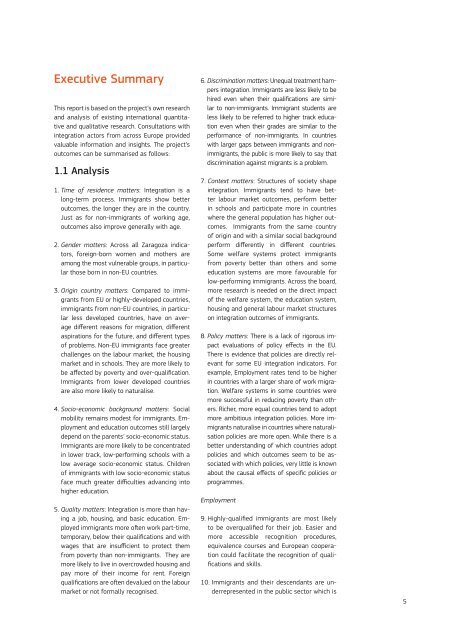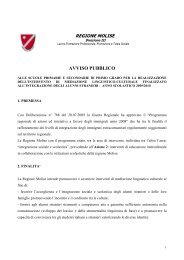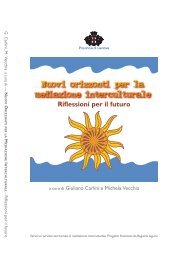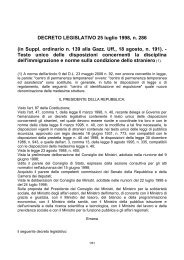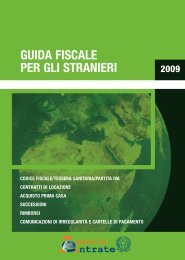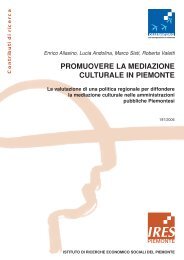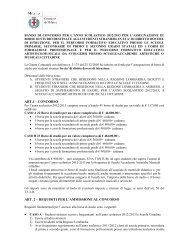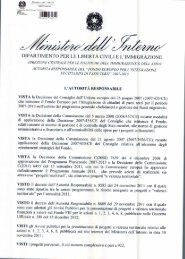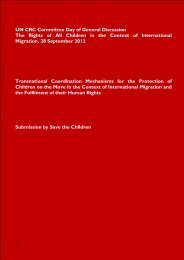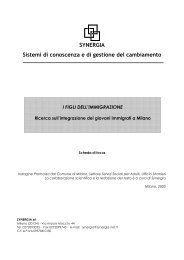Using EU Indicators of Immigrant Integration - European ...
Using EU Indicators of Immigrant Integration - European ...
Using EU Indicators of Immigrant Integration - European ...
- No tags were found...
Create successful ePaper yourself
Turn your PDF publications into a flip-book with our unique Google optimized e-Paper software.
Executive SummaryThis report is based on the project’s own researchand analysis <strong>of</strong> existing international quantitativeand qualitative research. Consultations withintegration actors from across Europe providedvaluable information and insights. The project’soutcomes can be summarised as follows:1.1 Analysis1. Time <strong>of</strong> residence matters: <strong>Integration</strong> is along-term process. <strong>Immigrant</strong>s show betteroutcomes, the longer they are in the country.Just as for non-immigrants <strong>of</strong> working age,outcomes also improve generally with age.2. Gender matters: Across all Zaragoza indicators,foreign-born women and mothers areamong the most vulnerable groups, in particularthose born in non-<strong>EU</strong> countries.3. Origin country matters: Compared to immigrantsfrom <strong>EU</strong> or highly-developed countries,immigrants from non-<strong>EU</strong> countries, in particularless developed countries, have on averagedifferent reasons for migration, differentaspirations for the future, and different types<strong>of</strong> problems. Non-<strong>EU</strong> immigrants face greaterchallenges on the labour market, the housingmarket and in schools. They are more likely tobe affected by poverty and over-qualification.<strong>Immigrant</strong>s from lower developed countriesare also more likely to naturalise.4. Socio-economic background matters: Socialmobility remains modest for immigrants. Employmentand education outcomes still largelydepend on the parents’ socio-economic status.<strong>Immigrant</strong>s are more likely to be concentratedin lower track, low-performing schools with alow average socio-economic status. Children<strong>of</strong> immigrants with low socio-economic statusface much greater difficulties advancing intohigher education.5. Quality matters: <strong>Integration</strong> is more than havinga job, housing, and basic education. Employedimmigrants more <strong>of</strong>ten work part-time,temporary, below their qualifications and withwages that are insufficient to protect themfrom poverty than non-immigrants. They aremore likely to live in overcrowded housing andpay more <strong>of</strong> their income for rent. Foreignqualifications are <strong>of</strong>ten devalued on the labourmarket or not formally recognised.6. Discrimination matters: Unequal treatment hampersintegration. <strong>Immigrant</strong>s are less likely to behired even when their qualifications are similarto non-immigrants. <strong>Immigrant</strong> students areless likely to be referred to higher track educationeven when their grades are similar to theperformance <strong>of</strong> non-immigrants. In countrieswith larger gaps between immigrants and nonimmigrants,the public is more likely to say thatdiscrimination against migrants is a problem.7. Context matters: Structures <strong>of</strong> society shapeintegration. <strong>Immigrant</strong>s tend to have betterlabour market outcomes, perform betterin schools and participate more in countrieswhere the general population has higher outcomes.<strong>Immigrant</strong>s from the same country<strong>of</strong> origin and with a similar social backgroundperform differently in different countries.Some welfare systems protect immigrantsfrom poverty better than others and someeducation systems are more favourable forlow-performing immigrants. Across the board,more research is needed on the direct impact<strong>of</strong> the welfare system, the education system,housing and general labour market structureson integration outcomes <strong>of</strong> immigrants.8. Policy matters: There is a lack <strong>of</strong> rigorous impactevaluations <strong>of</strong> policy effects in the <strong>EU</strong>.There is evidence that policies are directly relevantfor some <strong>EU</strong> integration indicators. Forexample, Employment rates tend to be higherin countries with a larger share <strong>of</strong> work migration.Welfare systems in some countries weremore successful in reducing poverty than others.Richer, more equal countries tend to adoptmore ambitious integration policies. More immigrantsnaturalise in countries where naturalisationpolicies are more open. While there is abetter understanding <strong>of</strong> which countries adoptpolicies and which outcomes seem to be associatedwith which policies, very little is knownabout the causal effects <strong>of</strong> specific policies orprogrammes.Employment9. Highly-qualified immigrants are most likelyto be overqualified for their job. Easier andmore accessible recognition procedures,equivalence courses and <strong>European</strong> cooperationcould facilitate the recognition <strong>of</strong> qualificationsand skills.10. <strong>Immigrant</strong>s and their descendants are underrepresentedin the public sector which is5


